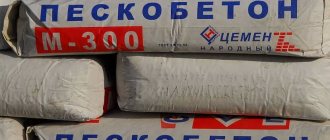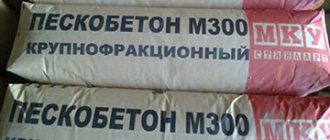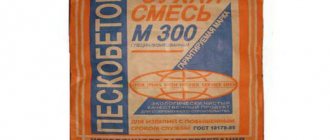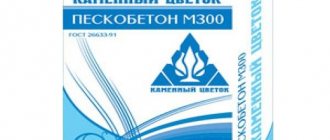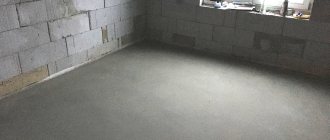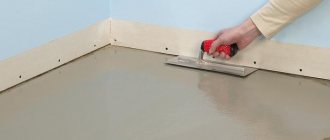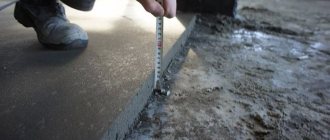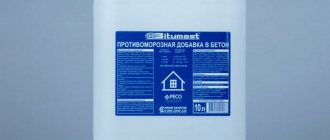Floor screed made from a cement-sand mixture is one of the most popular solutions for installing a base for a final coating. This design does not require the use of special equipment and can be done with your own hands in small rooms. To know exactly when it is better to lay a finished floor, you should study how long it takes for a sand concrete floor screed to dry.
What determines the drying speed?
When laying a wet screed on the surface of a concrete floor slab, or over a layer of compacted sand-gravel mixture of the base, the drying of the material will depend on a number of factors:
- Air humidity . It should be noted that you should not artificially dry the room where the cement-sand construction mixture is laid.
Cement is a hydraulic binder and hardens when there is a high concentration of water vapor in the air. When constructing a sand concrete subfloor, a humid environment with a water vapor concentration of 60% or higher should be provided. In such cases, strength gain will occur faster.
- Room temperature . Increasing the temperature during the period of strengthening of the cement-sand screed significantly accelerates the process of its hardening. This affects not only the drying speed, but also the load-bearing capacity and deformability of the finished product.
When the room temperature is less than 5 °C, additional plasticizers and antifreeze additives must be added to the mixture.
- Composition of raw materials . Sand concrete screed is a solution of a dry building mixture with water and, if necessary, plasticizing additives. Depending on the brand of cement, the structure has different hardening periods, which affects the development of design strength.
The granulometric composition of sand also affects these indicators. Pulverized aggregates harden much longer because they have a larger evaporation surface. Coarse river sand dries almost twice as fast. However, at the same time, the size and material of the sand grains affect the porosity coefficient of the finished structure.
- Structure thickness . When constructing a sand concrete screed, it is important to consider the thickness of the layer. The minimum thickness of the structure should be 30 mm, which requires complete drying up to 5 - 7 days. With a screed thickness of up to 70 mm, the wait extends to 2 weeks, and a structure with a thickness of more than 10 mm will take 3 weeks or more to dry.
The drying rate of the screed when installing floors on the ground is also influenced by such indirect criteria as the material and quality of the waterproofing device. The soil conducts capillary moisture well, and if waterproofing is ineffective, the porous structure of sand concrete will be constantly saturated with moisture, which greatly inhibits its drying and does not allow laying a finished floor.
From sand concrete
When a floor is formed using sand concrete, grade 300 cement is used. It is this composition that is considered the most universal. This material is actively used to produce a solution that can serve as a floor leveler. Read more about floor levelers in the article.
To accurately determine the readiness of a screed made of M300 sand concrete, it is necessary to focus on the recommendations for cement compositions. All time parameters are almost the same. You can read about floor screed made of sand and cement.
Why should you not use it before it dries?
When the screed hardens, a chemical reaction occurs in the sand-cement mixture associated with a change in the structure of the substance at the molecular level. In this regard, the polymerization of the material must be completed completely, and only after this the structure should be used for its intended purpose.
If the owner of the premises does not have time to wait, and the finishing coating is placed directly on top of the wet screed, negative consequences may occur:
- A damp screed does not have time to reach 100% load-bearing capacity, which can cause damage from mechanical stress during operation.
- Formation of fungus in the presence of water between the screed and the final moisture-proof coating. Stagnation of moisture leads to the proliferation of bacteria and the development of mold.
- Excess water remaining in the screed can penetrate the porous structure of the laminate, parquet board or plank floor, which will lead to their swelling and partial destruction. In such situations, owners often have to completely change the finished floor.
- When drying, the screed partially settles, by 0.5 - 1 mm, with a thickness of up to 100 mm. This curvature of the rough surface is compensated by self-leveling flooring or adhesive compositions. When installing finishing material immediately on top of the rough structure, the plane may move with the formation of bending and cracks.
- Also, when the sand concrete screed shrinks, the formation of thread-like cracks is observed due to the breaking of bonds in the structure of the material. If there is a finishing material made of tiles, such defects can cause its local destruction.
In addition to the problems listed above, when installing a finished floor on top of a damp screed, an unjustified increase in humidity in an already used room is possible. Such problems cause discomfort to residents and require the installation of dehumidifiers and other complex climate control devices.
Under tiles
Most often, a cement mixture is used to level the floor under the tiles. You can walk on this floor within the next 24 hours, but here’s what to do with the finishing. Based on the experience of already experienced people, we can say that the process of installing tiles can be carried out the next day. This is completely harmless, although not entirely advisable. If you entrusted the process of performing the work to strangers, then it is very important to check whether reinforcement was done.
And when choosing a material for a finished floor, it is useful to know which laminate is good for an apartment.
The thickness of the screed to be poured must be at least 4.5 cm. If the required thickness cannot be achieved, then the following measures must be taken: lay a plastic mesh with small cells on the screed. It is sold in rolls at any hardware store. After this, be sure to secure it with nails and cover it with a dry adhesive mixture, which will be used when laying the tiles.
The video shows how long it takes for a floor screed to dry:
A screed is a very necessary element to achieve a perfectly flat floor surface. Today there is a wide range of materials from which it can be made. As a result, it is very difficult to accurately determine the drying time of the solution used. In addition, it is worth taking into account factors such as temperature, layer thickness, humidity level and the type of material used. You may also be interested in information about the disadvantages of dry floor screed. The link describes the device for dry floor screed. The advantages of semi-dry floor screed are described. Also read which floor screed is better and cheaper. For strengthening, screeds are often reinforced with fiberglass.
Popular posts
- Chair for dressing table Chairs for dressing tables in Moscow - 189 Products Company from Moscow, delivery 29643 a In…
- Silicone sanitary sealant Silicone sanitary sealant white in Moscow - 1491 products Company from Moscow, delivery (tomorrow) 140...
- Shelf in the hallway Currently, there are a huge number of different options for shelves in the hallway, and this is directly ...
- Insulation of the floor in a wooden Insulation of the floor in a wooden house from below: materials and installation technology SHARE ON SOCIAL NETWORKS One of the common…
How long does it take for the screed to dry?
Sand-cement screed dries over different time periods, which depends on thickness, temperature and other factors given above. The average indicators of strength gain and complete evaporation of moisture from a freshly laid structure are given below:
- Standard “wet” screed with a thickness of up to 40 mm . It sets within 4 to 6 hours and dries completely in 4 to 5 days. You can carefully move around this structure 1 – 1.5 days after installation.
- The same, with a thickness from 40 to 70 mm . The setting period extends to 7 – 8 hours. Movement on the surface is possible after 2 days, and complete drying takes at least 10 - 14 days.
- “Wet” screed with a layer thickness of 70 mm and above . Such structures, as a rule, set within 12 – 18 hours. The application of a small load from the person’s weight is allowed after 3 days. Strength gains and moisture evaporation up to 2% occurs within 3–4 weeks after installation.
- Semi-dry sand-cement screed . It has a low water content, which requires less time for its evaporation. The semi-rigid sand-cement mixture sets almost instantly, and you can walk on the screed within an hour after smoothing. Hardening, depending on the thickness, lasts from 3 to 5 days, which is also influenced by the high porosity of the material, which is well ventilated.
When there is no time to wait, you should use the semi-dry screed technology, since the installation of a finished floor is allowed after 4 - 5 days with minimal risks of shrinkage and cracking in the finishing material.
Under laminate
Taking into account all the standards, the surface for installing the laminate should not have differences of more than 3 m by 1 m. If you are performing a wet screed under the laminate, then you must use special mixtures that are capable of self-leveling. Thanks to them, it is possible to facilitate the process of preparing the base. You can also use reinforcing fiberglass mesh for leveling. The floor must be poured in small sections and leveled using a special device.
When the screed has dried, you can proceed to sanding. The screed under the laminate takes about 2 weeks to dry. But here everything depends on the layer being laid. The process of installing the laminate is carried out after it has gained 50% strength.
How can you tell if the screed is dry?
To understand that the screed has dried, it is permissible to use traditional methods, or measure exact indicators using special equipment:
- A carbide hygrometer is a professional device that is highly accurate. The device scans not only the surface, but also the entire structure of the material, determining the exact percentage of water content in the screed structure. It is used on large construction sites under strict control by supervisory authorities.
- A moisture meter is a standard electronic tester that can be purchased at the construction market or at a hardware store. Upon contact with a wet structure, the device determines the moisture content of the material with an accuracy of 5%. Can be used when performing finishing work in private apartments or residential buildings.
- In the absence of equipment, the surface of the screed can be partially covered with PVC material and left in this position for 30 - 60 minutes. If wet drops form on the inner surface—the material becomes foggy—then the syringe is not ready for further use.
- The easiest way, which is accessible to everyone, is to lay an ordinary dry cloth on the surface of the subfloor, which easily absorbs moisture. If the paper becomes saturated with water, then the screed must dry for some time.
Experts do not recommend finishing the coating without checking the level of moisture in the screed, as incorrect actions can lead to the consequences described above. It should also be noted that control of the degree of humidity should be carried out at the cut, since the surface of the material dries much faster than the lower layers.
Cement
For a cement screed, the time for complete hardening is calculated using the formula:
- for thickness up to 4 cm: number of centimeters x 7 days;
- for thickness over 4 cm: 4x7 + number of additional centimeters x 15 days.
For example, if it takes 28 days to dry a coating 4 cm thick, then the time for complete hardening of a cement screed 8 cm thick will already be 88 days, that is, finishing the floor can only begin after 3 months.
To reduce the load on the floor when laying thick layers, experts recommend adding various fillers to the solution. It should be taken into account that the drying time of such a solution may increase, but it will be difficult to calculate how long the cement floor screed takes to dry in this case.
Tips and tricks
Experts often identify common errors in the operation of home meters and share useful information that helps achieve a positive result:
- Before laying the screed, you must read the instructions and add exactly as much water as is allowed to achieve the required strength.
- It is impossible to accelerate the hardening process of the sand-cement mixture with heat guns and other heating elements. Cement particles that have not had time to completely react with water will not be able to form a solid structure of the finished material.
- While waiting for the material to harden and dry, the degree of humidity should be constantly monitored.
If all technological requirements are met, a cement-sand screed will provide a reliable foundation for a finished floor of any category, which can be used for many years without the need for repairs.
conclusions
As you can see, there are certain features that will directly affect how quickly the screed dries. Including pay attention to the moisture level in the room. Also remember about the temperature. Under no circumstances should you neglect the thickness and number of layers in the solution.
After all, this directly affects time. It is also worth remembering about fillers that affect drying. The waterproofing base can have different levels of quality.
At first, you may be confused about how much time is needed to set and how much time is needed to dry. Interestingly, within 24 hours you can start walking on the flooring without leaving marks. After a week it may seem that the surface is very durable. However, this is deceptive.
After all, for example, cement has pores that contain water. It takes enough time to let it come out. Due to the fact that waterproofing has been laid under the bond layer, it is important to allow water to escape to the top. Otherwise, damage may occur - the coating will begin to become damp and deform.
Therefore, even when a week or two has passed, there is no need to rush, because there is enough moisture inside that needs to come out.
If you add a little filler to a solution that takes a long time to dry, you can greatly reduce the drying time. For this you can use:
- expanded clay;
- expanded polystyrene granules;
- basalt fibers;
- fiber fiber.
This method is called semi-dry screed. After all, in this case there is very little water in it. And it will take about a week for it to dry. But if you need to lay parquet or parquet boards, then you should allow about 3 weeks for drying.
It is also worth first familiarizing yourself with the methods of how to determine what the moisture content of the screed is. There are special devices for this. You can find out about them from specialists. In addition, there are methods that allow you to make such determinations without additional tools.
Taking into account the above points, you can achieve noticeable success in your repair.
Advantages of the M300 brand
Sand concrete M300 has earned its popularity due to its high versatility. It is very convenient when one material is suitable for different purposes. The main features of this brand are as follows:
- quite high strength;
- sufficient density;
- Possibility of application for external and internal work;
- high resistance to mechanical wear and shock loads;
- ease of use;
- long service life of products;
- rapid hardening of the solution;
- resistance to sudden changes in weather conditions;
- corrosion resistance;
- acceptable price.
At home, the simplest version of M300 sand concrete can be obtained by mixing one bucket of sand and 3.5 kg of M500 Portland cement. To obtain the finished solution, this amount of mixture will require 2.3 liters of water. It is advisable to use river sand. If you don’t have one, you can take a quarry one, but previously washed to remove soil and clay inclusions.
Peculiarities
Sand concrete is often referred to as an intermediate element between cement and concrete mixture. Dry material is often used for restoration, repair and construction work. It is lightweight and easy to work with, does not shrink, and has proven itself well on unstable soils. Sand concrete M200 is indispensable in the construction of concrete floors where serious loads are noted - garages, warehouses, shopping centers.
The mixture contains crushed stone and chemical additives, which ensures that the material does not shrink even with a fairly thick layer. Strength can be increased by using plasticizers, as well as ensuring sufficiently high frost resistance.
When adding various additives (especially to impart workability to the mixture), it is necessary to correctly determine the optimal volume in order to ensure the desired consistency without compromising the strength characteristics.
Pigments give sand concrete the desired color - there is also quite a wide variety here. The main thing is to choose the right supplement and work according to the instructions.
How to make cement harden quickly?
There is one way to radically accelerate the hardening of mortars without significant capital costs - by adding chemical setting and hardening accelerators to cement mortars at the stage of preparing the mortar.
Interesting materials:
How thick should I fill the blind area? What cement should I use? What is good quality cement? Which cement is best for a strip foundation? What cement is best to use for pouring the foundation? What cement is suitable for the foundation? Which cement is moisture resistant? Which plinth is best for the kitchen? Which insulation is best for attic floors? Which clapboard is better to decorate a steam room?
Structural repair of surfaces
EMACO, used for structural repairs, has high adhesion and no shrinkage. In addition, the solution works in close contact with the restored structure.
Characteristics of EMAKO structural compositions
EMAKO S66–S88 (self-leveling) and S88C (thixotropic type) are made on the basis of Portland cement, quartz sand, modifying master alloys and polymer fiber. Reinforcing the composition with fiber helps prevent the occurrence of shrinkage cracks, and Portland cement provides high-quality adhesion to the structure being repaired (see photo).
EMACO SFR
Compositions - SFR, S150CFR (self-leveling type) and S170CFR (thixotropic), are produced with flexible metal fiber and are used for repairing stressed concrete structures with damaged reinforcement.
Thanks to nanotechnology, the following brands appeared in the Emako product range: Nanocrete R3, R4, R4 Fluid. These are fast-hardening unique compositions that allow the application of a repair coating of great thickness on ceiling and vertical surfaces.
Selecting the required composition
Cement stone hydration process
To find out the drying time of the floor screed before facing with decorative materials, you need to clearly understand what processes occur inside the concrete. The main nuances of hydration (formation of high-strength cement stone in a poured volume) are:
- hardening is impossible without a sufficient amount of water, at the same time, 20% of the liquid by weight of dry cement is enough for hydration;
- first, needle-shaped crystals (aluminate structure) are formed in concrete, clinker minerals C2S, C3S (silicate structure) are formed between them;
- then the clinkers are strengthened, on the second day they displace aluminates, on the 28th day the structure consists of 90% silicates;
- It is this time that is considered to be the set of strength of cement stone; its further strengthening lasts for decades.
- the rate of hydration depends on the presence of additives, air temperature, water-cement ratio W/C, cement grinding and the mineral composition of the clinker included in its composition
The process of hydration of cement stone.
In the future, the indicator is influenced by concreting technology:
- to increase workability, 60–75% water by weight of cement is added to wet screeds (W/C = 0.6–0.75, respectively);
- during the formation of cement stone, only 20-25% of the liquid is bound, the rest is distributed in the pores of the structural material, during the transformation of silicate gel into solid stone, shrinkage of the surface occurs;
- chemical reactions inside concrete are accompanied by the release of heat, leading to intense drying of moisture;
- therefore, the surface is additionally moistened in the first 3 days so that the screed does not become covered with shrinkage cracks;
- slaked lime in cement prevents corrosion of reinforcement, gypsum slows down the hydration process, normalizes the structure of cement stone.
Thus, all of these factors should be taken into account in combination to obtain maximum adhesion of the tile adhesive to the concrete base of the floor slab.
Summarize
Thus, a novice craftsman or amateur will understand how long it takes to dry the floor, based on the combination of its thickness, materials and the principle of preparing the mixture.
The main criterion remains the correct design of the waterproofing layer, because moisture retention guarantees an optimal strength gain, without the likelihood of cracking in areas using reinforcing structures, laying engineering and communication systems. Complete drying of the screed guarantees trouble-free operation even in an unheated room.
